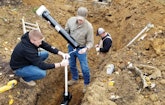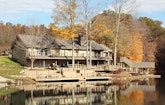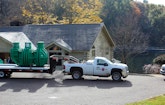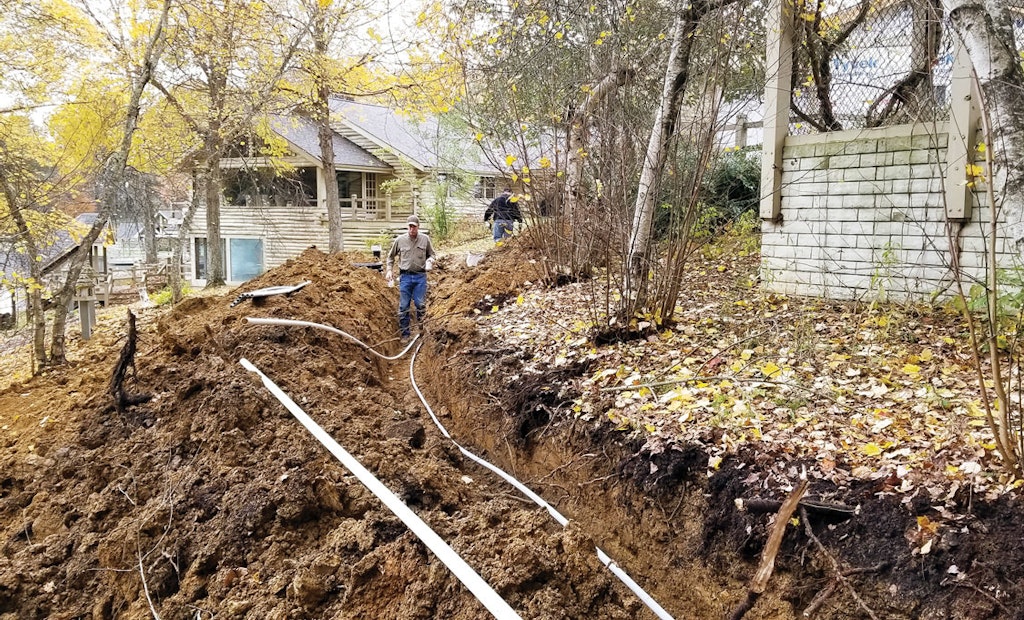Interested in Systems/ATUs?
Get Systems/ATUs articles, news and videos right in your inbox! Sign up now.
Systems/ATUs + Get AlertsWarrior Village, a Save A Warrior retreat in Heath, Ohio, lacked adequate sleeping quarters and bused 10 participants to a different location each night. Patrick Atkinson, chief financial officer, and Jake Clark, founder and president, believed converting a large garage into a bunkhouse would solve the problem.
They hired a general contractor and Howard Goodin of Goodin Electric to transform the building and add an onsite system. “Howard called us when it became apparent that the extensive landscaping and tight quarters took installing the system beyond their normal capabilities. However, the realization came only after they built the bunkhouse,” says Joe Celuch who, with his wife, Brenda, owns Beagle Hill Services in Frazeysburg.
Joe Celuch, his daughter, his son and some employees are military veterans. When they learned the Save A Warrior program is dedicated to ending the staggering suicide rate among active-duty military, veterans and first responders dealing with post-traumatic stress, they committed to designing and installing the $45,000 system at no cost and as fast as possible.
Regulatory agents agreed. Besides waiving fees, Chad Brown, RS, M.P.H., director of environmental health at Licking County Health Department, partnered with Celuch to expedite permits, approve the drawings and establish the hydraulic flow. “Bunkhouses don’t appear on standard hydraulic flow charts,” Celuch says. “The veterans get up, shower and don’t return until evening.”
Norweco, hearing of the project through Celuch, a distributor, donated the major components. Beagle Hill Services donated the design, dose tank, pump, electrical, labor and equipment. Other contributors included Joe Sidwell, trucking; Shelly Materials, aggregates; and WinSupply of Zanesville, pipe and fittings.
“I’ve never worked on such a harmonious project or one that came together this fast,” Celuch says. In late October 2018, his crew installed the pretreatment irrigation system in three days.
Site conditions
Soils are silt loam with the seasonal high water table 20 inches below grade. The 43-acre estate has a 3.3-acre pond, mature woods and an 18% slope behind the bunkhouse.
System components
Celuch designed the system to handle 500 gpd. Components are from Norweco unless specified otherwise.
- 600-gpd Singulair Green Bio-Kinetic aerobic treatment unit
- AT 1500 ultraviolet disinfection unit
- 1,500-gallon, single-compartment, low-profile polyethylene dose tank (Norwesco), Simplex high-head 1/2 hp effluent pump model HB105, and risers (TUF-TITE)
- 368 feet of PVC force main
- Two electric frost protection spray heads with No. 3 nozzle
- Service Pro weatherproof advanced surge protection (or WASP) 311T control panel.
System operation
Wastewater from the bunkhouse gravity-flows 29.5 feet through a 4-inch Schedule 40 PVC lateral to the aerobic treatment unit with nonmechanical flow equalization. Treatment occurs in the pretreatment, aeration and final clarification chambers. Activated sludge recirculates to the first chamber via a Bio-Static sludge return mounted in the aeration/clarification wall.
Effluent in the clarification chamber enters the Bio-Kinetic filter and is equalized and filtered. On discharge, it gravity-flows through the disinfection unit as it travels 6 feet to the dose tank. The pump sends liquid 292 feet up a 1:6 grade through a 1-inch Schedule 40 force main to the first head, then 76 feet through a 3/4-inch Schedule 80 force main to the second head. Beginning at 5 a.m. daily, the system runs 69 minutes, spraying 500 gallons over 4,538 square feet of mixed woods.
Heat tapes protect the irrigation system from freezing, as do King Drains (King Innovation), which drain aboveground spray equipment to No. 8 gravel weep pits. The 1-inch force main drains to the dose tank.
Installation
Norweco sent Drew Nickoli and Don Carabin, sales representatives, to assist with the installation. “They weren’t afraid of work and got along great with my guys,” Celuch says.
Celuch used a John Deere 325G compact track loader to cut a path up the hill and through the woods from the parking lot to the rear of the bunkhouse. Excavating the tank holes with a John Deere 50G compact excavator tested his 32 years of experience.
“It was an impossible location with almost nowhere to stockpile spoils,” he says. “Where to put each bucketful was a challenge. I used flower beds and built temporary mounds against trees. A pond was directly below where we were working, so I packed the soil to prevent it from sliding down the hill.” The 995-pound, 55.5-square-foot ATU and the 157- by 69- by 51-inch-high dose tank required a 9- and 7-foot-deep excavation respectively.
There was no way to transport the tanks mechanically from the parking lot to the holes. Taking a page from ancient builders, the crew set the ATU on PVC pipes and rolled it along the plastic wood deck surrounding the bunkhouse. Once at the rear of the building, Celuch used the excavator to lift the tank over the railing and set it in a flower bed. The dose tank traveled the same route.
“We transported aggregate with the track loader, weaving and waltzing to avoid bird feeders on posts, decorative lighting and similar obstacles,” Celuch says. “Everything else was carried in by hand.” The crew bedded the tanks on 6 inches of gravel and backfilled with 50 inches of aggregate.
Nickoli helped Earl Ridgley install the disinfection unit, then Celuch dug a 30-inch-deep trench for the force main. The machine just fit between a brick wall and the trees as Celuch worked backward up the slope. Bill Arnold used a Spectra Precision/Trimble laser to check elevations. Scott Bates laid the pipe, and Arnold solvent-welded the sticks. Arnold and Bates are veterans.
The spray heads, color-coded purple, were simple to install. “Just balance the pressure with the valves and make sure the spray trajectory meets the required radius,” Celuch says.
A day later, Celuch returned to find the area carpeted with freshly fallen leaves. “As challenging as this site was, disturbance to it was minimal,” he says. “Except for the spray heads, you couldn’t tell we’d been there.”
Maintenance
Every six months, a technician from Beagle Hill Services checks the pumps and alarms, spray heads and pattern, and confirms the irrigation area receives no more than 0.2 inches per day. He reviews the site, looking for landscape changes that would block the spray. The property owner is responsible for removing woody vegetation within a 5-foot radius of the heads, and trees 10 feet or taller within 10 feet of the irrigation area.











